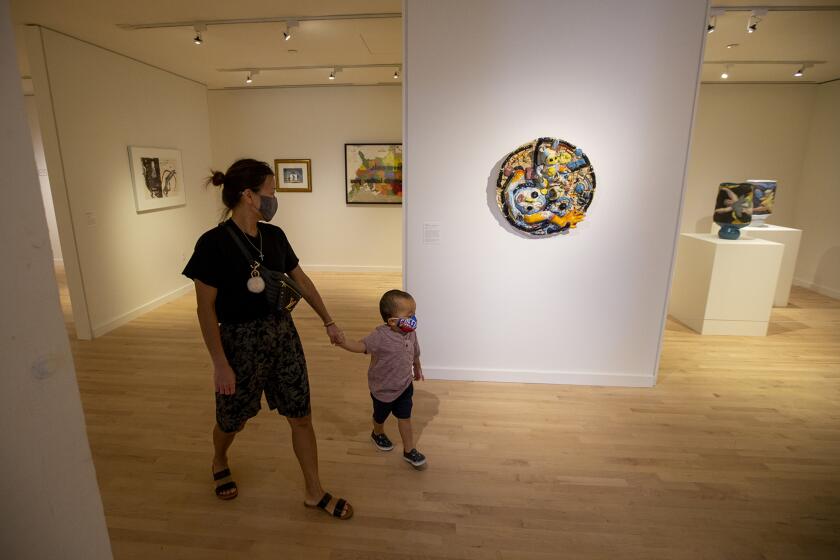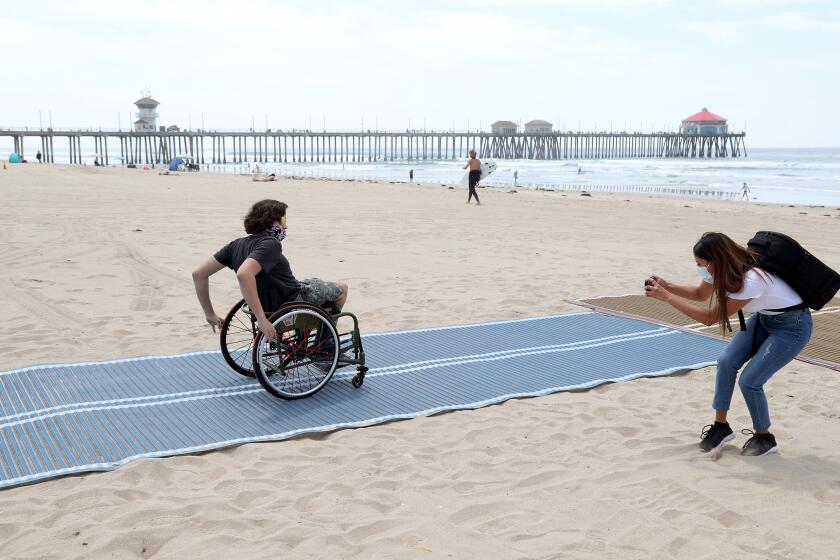3 art spaces collaborate on storefront exhibits featuring artist William Camargo
- Share via
Cal State Fullerton’s Begovich Gallery, Grand Central Art Center and MUZEO Museum & Cultural Center remain closed. But they are collaborating on a two-part exhibit making use of public space.
William Camargo was set to show his MFA thesis “Origins & Displacements: On Making Sense of Place, Histories & Possibilities” at Claremont Graduate University’s gallery, but then the campus shut down. His photography series examines the depiction and erasure of Chicanx and Latinx identity making use of historical documents and archived news material touching on topics related to gentrification, systematic racism and police brutality.
Some of the photos in the series feature Camargo holding signs in a significant location. In “Y’all Forget Who Worked Here?” Camargo stands in front of the Anaheim Packing House holding a sign reading “Brown women used to pack oranges here.”
“People of color get invalidated sometimes. A lot of that work that I was doing was looking at history and trying to bring up this memory of the folks that were invisible during that time too,” said Camargo in a June interview with TimesOC.
Jennifer Frias, director and curator of the Begovich Gallery, was familiar with Camargo’s work and kept thinking about the photography series throughout the summer when protests put social injustices on the forefront of peoples’ minds.
“It was very fitting and I saw his work as not just photographs. They’re educational tools, a form of activism or also a form of outreach,” said Frias.
Together they figured out a creative way to put on an exhibit accessible to the public, no matter the county’s COVID-19 tier status.
OCMA reopened in September and plans to honor artist Kori Newkirk at it’s Oct. 3 virtual gala as well as provide attendees with a look at OCMA’ s future plans.
Beginning Oct. 3, volume one of the series can be viewed from Grand Central’s 2nd Street promenade while volume two can be viewed from the storefront of MUZEO’s Carnegie building and sign boxes on the corner of south Anaheim and Broadway streets.
The exhibit purposefully relates to the city the art spaces are located in — each installation features Camargo’s research using the Santa Ana or Anaheim city historical and digital collections.
“It’s been interesting trying to figure out how to do things on the outside of the building instead of the inside. That’s apparently not something that anyone had tried before [at MUZEO],” said Katie Adams Farell, MUZEO’s interim executive director.
One of Camargo’s newer pieces is a photo of him holding a sign in front of Anaheim City Hall reading that four KKK members were elected into city council in 1924. Frias described it as one of the more powerful photos in the show. It’s going to be featured inside the MUZEO Historic Carnegie Library Galleries once it reopens on Nov. 21.
Gallery wall space will pose questions for visitors — “How far have we come? Where are we going?” and “How do we get there?”
Farrell said community is important to the museum’s mission, and Camargo’s series that extends inside the galleries is a chance for visitors to imagine what they want their community to look like in the future.
“People are sometimes discouraged to go into a museum, but what if they’re seeing these [outward] displays and it continues inside?” said Frias. “It becomes more welcoming.”
Frias later added, “When you think about murals and billboards, they have this immediacy to provoke thought and conversations. They convey messages of hope in grim times and having William’s photographs in front of a façade amplifies that sense of awareness and a call for resetting or decanonizing that system.”
Virtual programming related to the installations are scheduled on Oct. 13, Nov. 7 and Dec. 5. The exhibit runs until Dec. 31.
If you go
Grand Central Art Center
Where: 125 N. Broadway, Santa Ana
Info: grandcentralartcenter.com
MUZEO Museum & Cultural Center
Where: 241 S. Anaheim Blvd, Anaheim
Info: muzeo.org
All the latest on Orange County from Orange County.
Get our free TimesOC newsletter.
You may occasionally receive promotional content from the Daily Pilot.







